Your idea isn't going to work. It would work for short-term peak loads (like making toast)... but all your loads are continuous.
Sorry should've clarified, it's a (750W) power supply PC, 70 in (110W) TV, Echo Studio sound system (330W x 2), and 1500W heater, which I use even in the summer, might be cold blooded.
US/Canada power is 120V actually.
So that means 6.25 amps, 0.9A, 2.75A and 12.5A respectively.
Same concept works for other places, just factor for your power (100V Japan, 127V Brazil, 230V most of world).
I'm drawing quite a bit. Takes trip to breaker box... Doesn't seem to say the breaker specs on the box.
It's right on the handle!
It will say 15 or 20. Those are amps.

Amps is current flow. Volts is pressure/"head".
Look at your device's nameplate. Figure out device amps either by
- reading amps directly off the nameplate or
- looking for a "VA" figure and divide by 120 volts or
- looking for a "watts (input)" and divide by 120 volts
VA is an improved "watts" which reflects what loads actually draw in amps.
You could've worked it backwards and multiplied breaker handle x 120 and figured on watts/VA ... either way works. I like amps. Small numbers.
Now, every appliance has an "amps" number between 0 and 12.5.
Write it on the appliance if you must.
Back to the breaker handle. What's the number? Don't exceed it.
Not rocket science, my girlfriend does it every day. "Crock pot 2, heater 12. Want toast (7)? Set heater to low (7)."
Can I upgrade the circuit?
No, but you can add another circuit. Either hire an electrician, or honestly it's possible to learn to safely and legally DIY home electrical. Being an engineer gives you an edge since you have a sharp mind, and NOT being an electrical engineer means you'll accept Code wiring standards without argument (they make no sense to EEs at first; so EEs have a lot to unlearn).
Can I upgrade the circuit to more amps? NO. The breakers protect the wires, and the wires can't handle more amps.
Can I upgrade the circuit to more VOLTS without changing the wires? Maybe. And you'll get twice the practical power if you do. Building codes require 120V sockets in certain places. If you don't nee this circuit to meet that standard, you can simply re-mark the white wire as a ot, change the sockets from NEMA 5-15 to NEMA 6-15, and the breaker to 240V of same ampacity (It's a wider breaker though).
Some things (PC) can run on both 120V and 240V - check the nameplate spec. Others might need a different wall-wart. The heater is not one of them, but, you can easily buy built-in heaters that do run on 240V. They cost $40 and last for 30 years.
Hint: I know you're in North America because a "1500W heater" is defined by a UL spec relevant to 120V wiring. Most UL-spec 1500W heaters have a "low" setting.
P.S. that 1500W heater costs 20 cents an hour to run.
